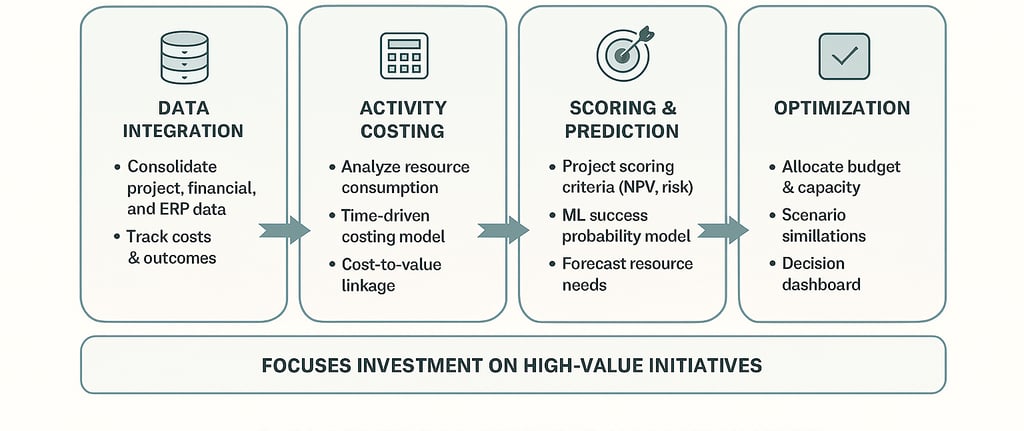Optimising R&D Resource Allocation for a Mid-Size 3D Printing Company
Reallocation of resources increased ROI on R&D spend by 22% within one fiscal year.
Client Context
A mid-size 3D printing manufacturer specializing in advanced polymer and metal additive technologies was experiencing rapid growth but faced increasing R&D inefficiencies. With multiple innovation streams—material science, hardware engineering, and software integration—the company struggled to prioritize projects, manage limited budgets, and align R&D outcomes with commercial objectives.
Leadership sought a data-driven framework to allocate R&D resources dynamically, improve ROI on innovation spend, and reduce time-to-market for commercially viable technologies.
Key Challenges
Fragmented Resource Allocation: R&D funds and engineering capacity were spread thinly across too many experimental initiatives with unclear commercial value.
Limited Visibility: Lack of transparency in how time, budgets, and expertise were distributed across teams and technology tracks.
Subjective Prioritization: Project selection driven by intuition and technical enthusiasm rather than objective metrics like market potential or NPV.
Bottlenecks in Talent Utilization: Highly specialized engineers were overloaded, while other teams had underused capacity.
Disconnect Between R&D and Product Strategy: New developments often missed strategic alignment with market demand or customer segments.
Solution Design
Hal Praxis implemented a Dynamic Resource Optimization Framework combining financial analytics, portfolio modeling, and machine learning to optimize R&D spending, capacity, and project prioritization.
Key Components
R&D Portfolio Data Integration
Consolidated project data from engineering systems (PLM), project tracking tools (JIRA), and financial systems (ERP).
Mapped human capital allocation (engineer hours, lab usage) against project objectives and outcomes.
Activity-Based Costing for R&D
Introduced time-driven activity-based costing (TDABC) to quantify resource consumption by project phase (design, prototyping, validation).
Calculated true cost per R&D initiative and linked it to projected business value.
Project Scoring & Prioritization Model
Developed a multi-criteria scoring framework using financial, technical, and strategic factors (NPV, TRL, market potential, IP value).
Applied weighted decision modeling and scenario simulation for optimal project mix.
Machine Learning Forecasting
Built predictive models to estimate project success probability, potential ROI, and resource demand using historical project data.
Identified drivers of project delays and overspend (e.g., iteration cycles, material complexity).
Optimization & Simulation Engine
Used linear programming to balance funding, human capital, and timeline constraints.
Generated “what-if” scenarios for headcount reallocation, outsourcing, or deferral of low-priority projects.
R&D Analytics Dashboard
Created an executive dashboard showing R&D investment by technology, success probability, and commercial readiness.
Included alerts for overrun risks, low-yield initiatives, and upcoming capacity bottlenecks.
Key Deliverables
R&D Portfolio Heat Map – visualizing project attractiveness vs. resource intensity.
Resource Optimization Model – quantitative tool for optimal allocation across projects and teams.
Predictive Project Performance Models – ML forecasts for probability of success and cost-to-completion.
Activity-Based Cost Reports – detailed cost breakdowns by project, function, and technology.
Decision Dashboard – real-time visibility into spend, capacity, and prioritization scenarios.
Governance Framework – structured review cadence linking R&D investments to business strategy.
Business Impact
Increased R&D ROI: Reallocation of resources increased ROI on R&D spend by 22% within one fiscal year.
Shorter Time-to-Market: Average product development cycle reduced by 18%.
Improved Focus: 30% reduction in non-strategic or low-viability projects.
Better Talent Utilization: Engineering workload rebalanced, improving overall productivity by 15%.
Enhanced Strategic Alignment: Portfolio decisions now directly linked to market opportunities and corporate roadmap.
Conclusion
The Dynamic R&D Resource Allocation Model transformed the client’s innovation management approach from intuition-driven to data-driven and financially grounded.
By merging financial analytics with machine learning and optimization models, the company now continuously aligns its R&D investment with strategic value creation, achieving faster innovation and sustainable growth in the competitive 3D printing sector.


© Hal Praxis 2025. All rights reserved.
Register Code: 304291595
Anapilio 30 Vilnius, Lithuania
